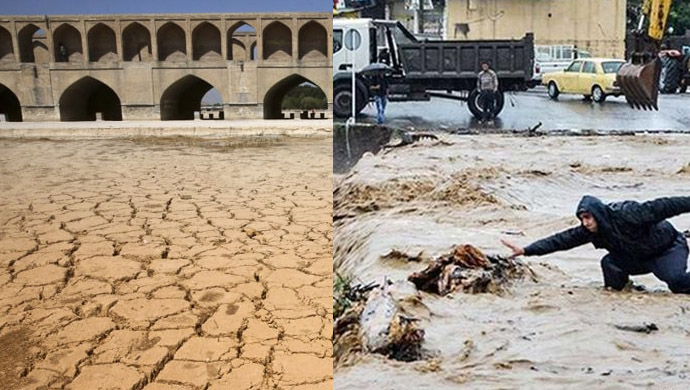Once again, Iran is ravaged by seasonal floods. Eighty-seven cities and hundreds of villages in 17 provinces have been hardly hit by floods and heavy rain that began on Saturday. Many people, especially in rural areas, have no shelter and the minimum facilities to protect themselves against floods.
By Tuesday, at least 11 people had died in the floods and several others have been injured or have gone missing. In some areas such as Konarak, thousands of homes have been flooded and more than 10,000 people are homeless and stranded as water levels are rising. Power lines are cut off, streets are filled with muck, and the government response has been virtually non-present.
The tragedy of Iran is that every year, the country is hit by both drought and floods. And this is happening recurrently. This time around, as floods ravaged parts of the country, in other regions people were suffering from water shortages.
Some 30 provinces are faced with water shortages, and in six provinces, the situation is critical. Instead of responding to protests, regime officials blame nature and lack of precipitation for water shortages. But the recurring flash floods happening every year since 2019 show that there’s no shortage of precipitation in Iran and if managed properly, damages could be mitigated and water sources could be provided to needy regions.
In fact, the disruption of Iran’s ecosystem is the result of the ruling mullahs’ decades of mismanagement and destructive policies. The destruction of Iran’s natural resources by the Revolutionary Guards and other regime organs has resulted in disasters such as drought, floods, dust storms, and other problems.
The regime’s mismanagement of natural resources is so evident that the regime’s own media are discussing it. Exploring the simultaneity of drought and floods, the state-run Mardom Salari wrote on January 4, “In the past few years, the environmental situation is very contradictory… this situation is the result of negligence and mismanagement in different periods.”
The reason behind the “contradictory situation” is not a secret.
The examination of floods since the spring of 2019—even by the regime’s own experts—clearly shows that it is the mullahs’ regime that is responsible for the situation.
For example, the destruction of forests in Iran has made different regions much less resistant to seasonal floods. At the same time, the unscientific and mismanaged building of dams on different rivers and extracting underground water has changed the balance of water distribution, causing drought in different areas, creating a major subsidence problem, and drying up marshes in different regions.
According to different studies, every acre of forest can preserve 2,000 cubic meters of water. Due to deforestation, mainly done by companies and organizations linked to the Revolutionary Guards, rainfall quickly turns into a flood.
Moreover, since 2019, the national weather organization has predicted and warned about floods in advance. But the regime has taken no preventive measures to reduce the damage.
On the other hand, after the floods strike, the regime has had no crisis management plan and do nothing to help stranded people and provide them shelter. At the same time, while the regime has given a massive boost to the budget of the Revolutionary Guards and its propaganda apparatus, it has done nothing to bolster the bodies that are supposed to maintain the environment and respond to environmental disasters.
In recent years, the share of the budget for construction and crisis response has continuously declined. In 2013, the share of the budget for such purposes was 30 percent. But in 2022, that share has fallen to 11 percent. According to the Sharq newspaper, even this meager budget has not been fulfilled and 60-80 percent of it has not been absorbed or allocated to suitable projects.
At the same time, the people of Iran are becoming more aware of the regime’s role in environmental disasters and that Iran’s environmental crises will only go away when the mullahs’ regime is replaced with a democratic government that has given priority to the people and country’s interests.





